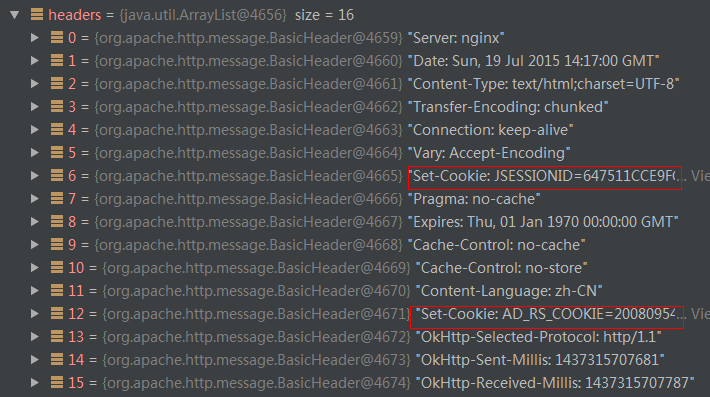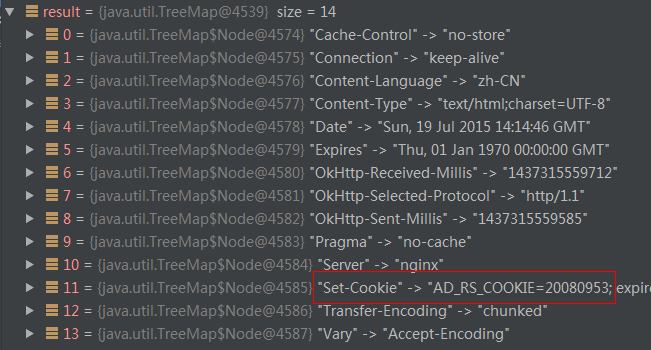问题出在BasicNetwork的performRequest()方法中,出问题的代码如下:
public NetworkResponse performRequest(Request<?> request) throws VolleyError { long requestStart = SystemClock.elapsedRealtime(); while (true) { HttpResponse httpResponse = null; byte[] responseContents = null; Map<String, String> responseHeaders = Collections.emptyMap(); try { // Gather headers. Map<String, String> headers = new HashMap<String, String>(); addCacheHeaders(headers, request.getCacheEntry()); httpResponse = mHttpStack.performRequest(request, headers); StatusLine statusLine = httpResponse.getStatusLine(); int statusCode = statusLine.getStatusCode(); responseHeaders = convertHeaders(httpResponse.getAllHeaders()); // Handle cache validation. if (statusCode == HttpStatus.SC_NOT_MODIFIED) { Entry entry = request.getCacheEntry(); if (entry == null) { return new NetworkResponse(HttpStatus.SC_NOT_MODIFIED, null, responseHeaders, true, SystemClock.elapsedRealtime() - requestStart); } // A HTTP 304 response does not have all header fields. We // have to use the header fields from the cache entry plus // the new ones from the response. // http://www.w3.org/Protocols/rfc2616/rfc2616-sec10.html#sec10.3.5 entry.responseHeaders.putAll(responseHeaders); return new NetworkResponse(HttpStatus.SC_NOT_MODIFIED, entry.data, entry.responseHeaders, true, SystemClock.elapsedRealtime() - requestStart); } // Some responses such as 204s do not have content. We must check. if (httpResponse.getEntity() != null) { responseContents = entityToBytes(httpResponse.getEntity()); } else { // Add 0 byte response as a way of honestly representing a // no-content request. responseContents = new byte[0]; } // if the request is slow, log it. long requestLifetime = SystemClock.elapsedRealtime() - requestStart; logSlowRequests(requestLifetime, request, responseContents, statusLine); if (statusCode < 200 || statusCode > 299) { throw new IOException(); } return new NetworkResponse(statusCode, responseContents, responseHeaders, false, SystemClock.elapsedRealtime() - requestStart); } catch (SocketTimeoutException e) { attemptRetryOnException("socket", request, new TimeoutError()); } catch (ConnectTimeoutException e) { attemptRetryOnException("connection", request, new TimeoutError()); } catch (MalformedURLException e) { throw new RuntimeException("Bad URL " + request.getUrl(), e); } catch (IOException e) { int statusCode = 0; NetworkResponse networkResponse = null; if (httpResponse != null) { statusCode = httpResponse.getStatusLine().getStatusCode(); } else { throw new NoConnectionError(e); } VolleyLog.e("Unexpected response code %d for %s", statusCode, request.getUrl()); if (responseContents != null) { networkResponse = new NetworkResponse(statusCode, responseContents, responseHeaders, false, SystemClock.elapsedRealtime() - requestStart); if (statusCode == HttpStatus.SC_UNAUTHORIZED || statusCode == HttpStatus.SC_FORBIDDEN) { attemptRetryOnException("auth", request, new AuthFailureError(networkResponse)); } else { // TODO: Only throw ServerError for 5xx status codes. throw new ServerError(networkResponse); } } else { throw new NetworkError(networkResponse); } } } }
convertHeaders()方法如下:
protected static Map<String, String> convertHeaders(Header[] headers) { Map<String, String> result = new TreeMap<String, String>(String.CASE_INSENSITIVE_ORDER); for (int i = 0; i < headers.length; i++) { result.put(headers[i].getName(), headers[i].getValue()); } return result; }
convertHeaders()方法中对HttpResponse的headers进行处理,转换成了TreeMap<String,String>,TreeMap中不能出现重复的键,那么如果有相同的键,数据就会被覆盖,如下图:


解决办法:
1、修改OkHttp库中对http header的解析;将相同的键放一起(未验证);
2、修改convertHeaders()方法,对相同的键做判断处理,如下:
protected static Map<String,String> convertHeadersFixed(Header[] headers){ Map<String, String> result = new TreeMap<String, String>(String.CASE_INSENSITIVE_ORDER); for (int i = 0; i < headers.length; i++) { String name = headers[i].getName() ; String value = headers[i].getValue() ; if(result.containsKey(name)){ String existValue = result.get(name); existValue+=";"+value; result.put(name, existValue); }else { result.put(name, value); } } return result; }
至于为什么是添加分号处理,参照于http header中的“Content-Type: text/html;charset=UTF-8”此种格式。